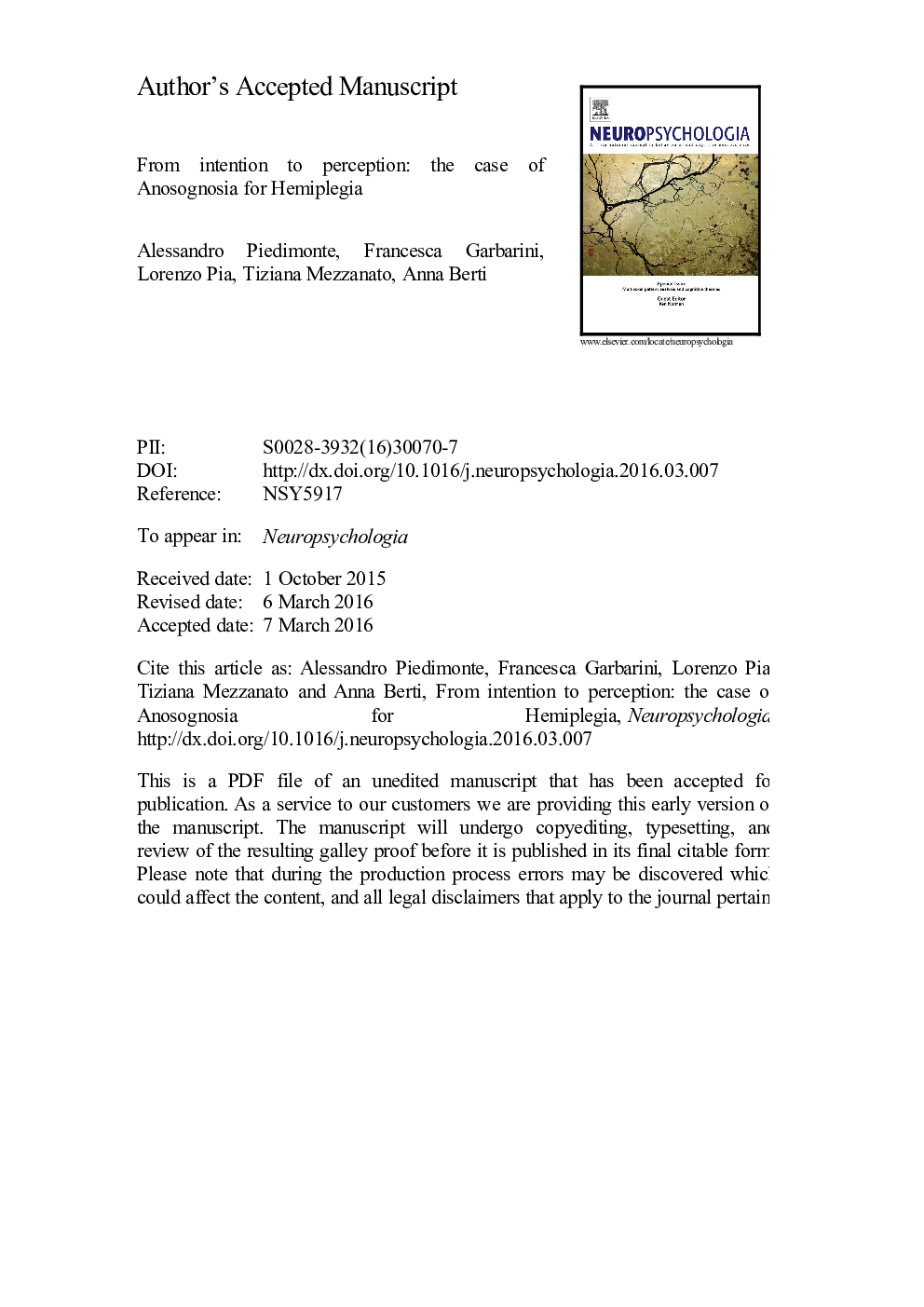| کد مقاله | کد نشریه | سال انتشار | مقاله انگلیسی | نسخه تمام متن |
|---|---|---|---|---|
| 7318955 | 1475567 | 2016 | 29 صفحه PDF | دانلود رایگان |
عنوان انگلیسی مقاله ISI
From intention to perception: The case of anosognosia for hemiplegia
ترجمه فارسی عنوان
از قصد به ادراک: مورد آنزونگوزیا برای همی پلژی
دانلود مقاله + سفارش ترجمه
دانلود مقاله ISI انگلیسی
رایگان برای ایرانیان
ترجمه چکیده
بیماران آسیب دیده مغزی با آنزونگوزیا برای همی پلژی انکار نارسایی حرکتی خود را می پذیرند و معتقد هستند که هنوز می توانند اندام فلج شده را حرکت دهند. مطالعات قبلی نشان می دهد که آنزونگوزیا می تواند از عمق حرکت های ناشی از حرکات و برنامه ریزی برای دست زدن به ناخن جلوگیری کند. با این حال، مطالعات اندکی بر ارتباط بین این قصد و ادراک رنجور و درک متمرکز شده است. برای بررسی بیشتر این موضوع، ما از یک پارادایم حرکت ظاهری استفاده کردیم، جایی که یک محرک یک حرکت مبهم ایجاد کرد و شرکت کنندگان به سادگی خواسته شدند قضاوت کنند (راست یا چپ). ما تأیید کردیم که وقتی شرکت کنندگان سالم از کلید یا دست راست یا چپ خود برای فشار دادن یک حرکت ظاهری خواسته می شوند، آنها یک تعصب ادراکی در جهت حرکت دست نشان می دهند. هر دو روش دو جانبه و غیرمعمول (به عنوان مثال، فشار دادن کلید با دو دست یا به صورت یک طرفه) از همان پارادایم حرکت ظاهری به دو گروه از افراد سالم تجویز شد. جالب توجه است، شرکت کنندگان تنها در شیوه دو طرفه دوجنبه نشان دادند که تعصب ادراکی قابل توجهی دارند. بیماران همی پلژی با و بدون آنوسونوگرافی، از انجام وظیفه دو طرفه درخواست کردند. بیماران بدون آنزونگوزیا، کاملا از کمبود حرکتی چپ خود آگاه هستند، فقط حرکات دست راست را برنامه ریزی می کنند، رفتار مشابه با کنترل های سالم انجام کار غیرمعمول. برعکس، در بیماران مبتلا به آنزونگوزیا، یک انگیزه مؤثر حرکتی برای دست چپ (پریشی) بر روی ادراک بصری تأثیر گذاشت و موجب برانگیختگی ادراکی مشابهی شد که در کنترل های سالم انجام می شد و در حال انجام حرکات دو طرفه بود. این یافته ها نشان می دهد که داشتن یک نمایندگی موتور خاص می تواند منجر به نتایج متفاوت در درک جهان خارج شود.
موضوعات مرتبط
علوم زیستی و بیوفناوری
علم عصب شناسی
علوم اعصاب رفتاری
چکیده انگلیسی
Brain-damaged patients with anosognosia for hemiplegia deny their motor deficit and believe they can still move the paralyzed limb. Previous studies suggest that anosognosia can arise from intact motor intentionality and planning for the plegic hand. However, few studies focused on the relationship between this spared intentionality and perception. To further investigate this topic, we used an apparent motion paradigm, where a stimulus generated an ambiguous motion and participants were simply asked to judge its direction (right or left). We confirmed that, when healthy participants are asked to press a key either with their right or left hand, triggering the apparent motion, they show a perceptual bias toward the direction of the moving hand. Both bimanual and unimanual modalities (i.e. key pressing with-both-hands or with-one-hand, respectively) of the same apparent motion paradigm were administered to two groups of healthy participants. Interestingly, only in the bimanual modality, participants showed a significant perceptual bias. Hemiplegic patients with and without anosognosia, were requested to perform the bimanual task. Patients without anosognosia, fully aware of their left motor deficit, only programed right hand movements, behaving similarly to healthy controls performing the unimanual task. On the contrary, in patients with anosognosia, an effective motor intentionality for the left (plegic) hand influenced visual perception, giving rise to similar perceptual bias as that found in healthy controls actually performing bimanual movements. These findings suggest that having a specific motor representation can lead to different outcomes in the perception of the outside world.
ناشر
Database: Elsevier - ScienceDirect (ساینس دایرکت)
Journal: Neuropsychologia - Volume 87, 1 July 2016, Pages 43-53
Journal: Neuropsychologia - Volume 87, 1 July 2016, Pages 43-53
نویسندگان
Alessandro Piedimonte, Francesca Garbarini, Lorenzo Pia, Tiziana Mezzanato, Anna Berti,
